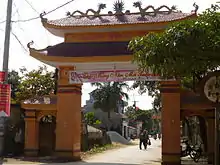Tam quan
A Tam quan (Chữ Hán: 三關) or Tam môn (Chữ Hán: 三門) is a kind of traditional gateway of Vietnamese Buddhism, has three aisles (traditionally, the middle aisle is the largest and the two side aisles are smaller) not only are they applied in Buddhist works, they are also commonly applied to other religious works such as Confucianism, Taoism, Vietnamese folk religion, Đạo Mẫu,... and even Christianity. In addition, they are also applied to non-religious modern buildings such as schools, People's committees,....
| Tam quan | |
|---|---|
.jpg.webp) A typical Tam quan of folk architecture | |
 Tam quan of Nghiêm Quang temple, Thận Trai village, Bắc Ninh | |
| Vietnamese name | |
| Vietnamese alphabet | Tam quan |
| Chữ Hán | 三關 |
Origin and meaning
.jpg.webp)
Origin
The ancient torana is sacred gateway architecture found all over the Indian subcontinent. It has influenced the gateway architecture further across asia via the Silk Road transmission of Buddhism; Chinese paifang gateways[1] Japanese torii gateways,[1][2] Korean hongsalmun gateways,[3] Vietnamese tam quan gateways[4]and Sao Ching Cha in Thailand[2] have been derived from the Indian torana. The functions of all are similar, but they generally differ based on their respective architectural styles.[5][6]In addition to originating from India, the Tam quan gateways is also influenced by Chinese architecture.[7]
Meaning
The Tam quan carries the concept of "three ways of seeing" of Buddhism, including "hữu quan 有覌", "không quan 空覌" and "trung quan 中覌",[8][9] representing the form (false), the void (anitya) and the middle of both.[10] The second explanation is that the three gates are the gates of the Three Jewels.[11] Another theory holds that the three gates are the "Samadhi" of the Zen sect. Therefore, countries that do not belong to Zen Buddhism do not have Tam quan as the entrance to the temple.
Architecture
Tam quan is mainly three aisles with the middle door usually larger than the two side doors. The wall of the gateway can be woodor build a wall brick or stone. Above the gateway with a tiled roof. The two sides of the path are often decorated with couplets, the front of the door is written with the name of the temple or the name of the gateway.
The original gateway


Is the primitive gateway form and is also the most common type. Only roof and three paths, in front of the temple's name.
The gateway has an upper floor

Small gateways only make one floor, but when built on a larger scale, many places build two roofs or build upper floors. Brick and stone gates almost always have an upper level, although it may just be a fake upper floor to create height. There are places built into three floors. When designing the upper floor, there is a pagoda that uses it to hang the bells, the plaques, and the drums used in temple rituals...
Gateway style of four pillars

Tam quan style of four pillars instead of building walls, uses four pillars, the middle two pillars are higher than the two side pillars to divide into three paths. Above, connecting the four pillars is a stylized beam to make the gate's forehead (some places do not connect the four pillars).

The gateway of Láng Pagoda is characterized by a four-pillar structure with a curved roof, giving the pagoda's Tam quan a unique and unique shape in the traditional architecture of Vietnam.[12]

Some popular variations


Variations of the Tam quan are found in some pagodas built into five aisles such as in the case of Sét pagoda, Hanoi.
Application in non-religious works
Tam quan is applied to many non-religious public works in Vietnam.
School gate




Village gate
Traditional Vietnamese village gates usually have only one path (although there are also some places built in the form of a Tam quan), but many places today will build a village gate in the form of a Tam quan to use as a kind of welcome gate.





.jpg.webp)
Welcome gate

.jpg.webp)
See also
- Nghi môn, in Vietnamese temple architecture
- Trụ biểu, in Vietnamese temple architecture
- Torana, in Indian temple architecture
- Paifang, in Chinese temple architecture
- Torii, in Japanese temple architecture
- Hongsalmun, in Korean temple architecture
- Iljumun, in Korean temple architecture
Refer
- Nguyễn Bá Lăng. Vietnamese Buddhist Architecture Vol. II. Paris: Nguyễn Bá Lăng, 2001.
References
- Albert Henry Longhurst (1992). The Story of the Stūpa. Asian Educational Services. p. 17. ISBN 978-81-206-0160-4.
- Scheid, Bernhard. "Religion in Japan". Torii (in German). University of Vienna. Retrieved 12 February 2010.
- A.H. Longhurst (1995). Story Of The Stupa. Asian Educational Services. pp. 17–. ISBN 978-81-206-0160-4.
- From Torana gateways to Tam quan gateways
- Ronald G. Knapp (2000). China's old dwellings. University of Hawaii Press. p. 85. ISBN 0-8248-2214-5.
- Simon Foster; Jen Lin-Liu; Sharon Owyang; Sherisse Pham; Beth Reiber; Lee Wing-sze (2010). Frommer's China. Frommers. p. 435. ISBN 978-0-470-52658-3.
- Tam quan in Vietnamese temple architecture
- What does Tam quan mean?
- Meaning and symbolism of Tam quan gate
- Tam quan Danang newspaper July 5, 2014
- Meaning of Tam quan
- The spread of the Tam quan of Láng pagoda
